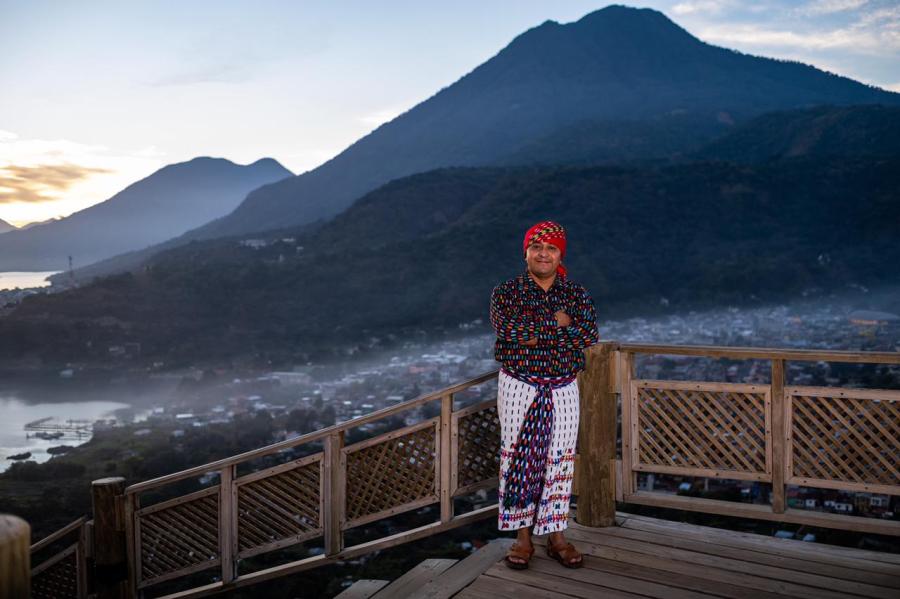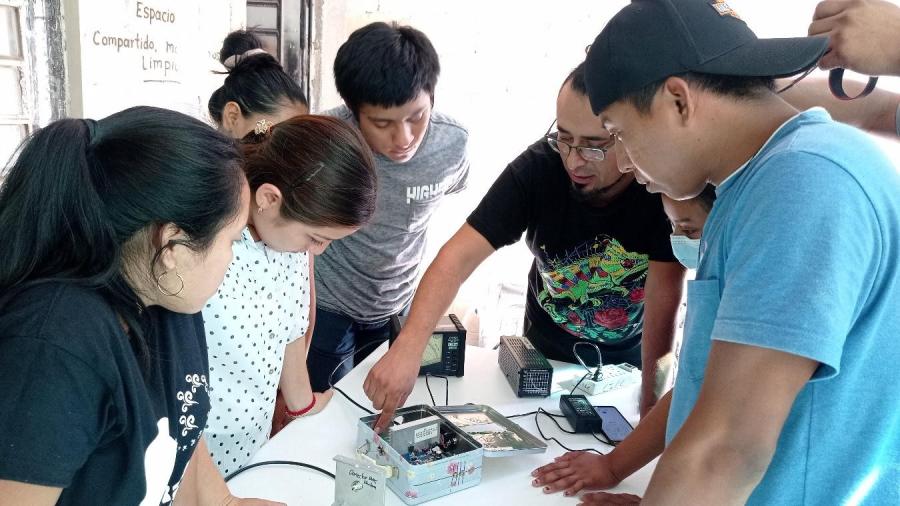In highland Guatemala the term "Indian" or indigena is a widely used and locally accepted means of categorizing people. It characterizes highland inhabitants seen in public roles and is generally contrasted with the term Ladino (or non-Indian). The exact sense of the term "Indian" varies, however, according to who is doing the viewing.
Non-Indians from the national level on down equate "Indian" with "Guatemalan" in expressions of Guatemalan national identity. Embracing the spirit of the Indian as their own, Ladinos, in fact, proclaim themselves to be of the same historical essence (if not always of the same blood).
On the international level the use of the Indian image as the image of Guatemalan national identity is seen yearly in the "Mis Universo" contest. Each July the Ladino woman who is elected Miss Guatemala represents her country in the world pageant decked out in Guatemala's "national costume" - that is, traje or Indian dress. By proclaiming ties to a rich Mayan heritage, Guatemalans are united and shown to be different from every other people on earth.
Similar embraces of Indian identity occur for strictly national audiences. For example, February 20 is the day set aside for honoring Tecun Uman, the Quiche Maya prince defeated by the Spanish conqueror Pedro de Alvarado. Proclamations emanating from the capital (from non-Indian sources) herald him as an ancestor to all: "the symbol of Guatemalan nationality" and "American man" made "without distinguishing between Indian and Ladino." Indians, however, point out the irony of these claims, especially in light of what is seen as increasing government repression of indigenous communities.
It is not just at the national level or for foreign audiences that Ladinos embrace or "become" Indian as an expression of what it is to be Guatemalan. At a local fair celebration, both Ladino and Indian candidates for the fair queens first appeared on stage in traje or Indian dress. The fair production was a product of local cooperation between Indian and Ladino groups after several years of friction between the two, and the appearance of all the girls in traje was seen to be a unifying statement expressing (as the emcee proclaimed) "nuestra Guatemalidad" - "our Guatemalaness" or common heritage - in an era of deep social division.
Indians also point to tourist literature as a non-Indian characterization of the Indian and of Guatemala-as-Indian. In these publications, Guatemalans in general (including Indians, noted as such by their dress) are portrayed as smiling, beckoning locals who welcome foreigners and offer them the luxuries of an exotic vacation.
There is, however, another aspect of the Guatemalan Indian portrayed in the tourist literature which begins to move us away from an image of the Indian as symbol for all that is Guatemalan - both Indian and non-Indian - to an image of the Indian as a unique being, essentially different from a notable segment of the local population as well as virtually all of the rest of the world. To emphasize this perceived gulf between los naturales and the rest of the population, special emphasis is placed on the seemingly foreign, non-Western qualities of indigenous activities and beliefs: Indians are shown worshipping at stone altars or in dark, smoky, candle-lit churches; weaving on backstrap looms; or trodding along dirt roads, barefoot and laden with goods on their heads. Labels to such scenes describe the Maya as "mysterious" and "enigmatic," and their culture as "confused" and "decadent." The most extreme versions of this negative portrayal of indigenous people have Indians as completely distinct from non-Indian Guatemalans and their non-Guatemalan "Western" affiliates, and depict them as innately inferior beings, more closely approximating animals than humans.
In certain local settings, extreme negative characterizations of Indians often do not occur in public. Because of local circumstances, social etiquette, a sensitivity to a volatile topic, and instances of genuine friendship between individuals considered to be of different ethnic groups, public expression of these sentiments is complex and seldom emerges in a direct (and directly offensive) manner.
Indian perspectives on the Indian also include a number of distinct characterizations, ranging from a negative self image which Indians see forced on them by virtue of their position in the wider Guatemalan social structure, to a positive view of Indians practicing their traditional customs and holding responsible jobs, proudly and with due respect from all segments of society.
Indians condemn the fact that while Ladinos seem to embrace Indians, their actions actually victimize them. Social policies presented by non-Indian policymakers as affecting all Guatemalans equally are, Indians charge, really discriminatory. For example, the system of government farm loans purportedly available to all citizens with a certain amount of land is seen locally as discriminating against Indians, the only people in the area with less than the minimum of land who need and want the financial aid. Ladinos are also criticized for using the Indians for financial gain: they exploit Indians as laborers and they use the Indian image for the purposes of tourism.
Given this overwhelmingly prejudiced social environment, Indians often choose special, more private opportunities to express of their ethnicity. Generally these are played out in the privacy of domestic life or in public celebrations specifically aimed at the Indian community. The latter, public (or semi-public) events are seen as especially important means for promoting a sense of social solidarity. At this time I will only mention one such example, a public presentation of highland traje arranged by an all-Indian organization in one highland town.
Planned for fairtime 1980, this public presentation of traje inaugurated a weeklong exhibition of the same. During the presentation, speakers, who addressed the audience in the local Mayan language, encouraged Indians to wear traditional dress, to refrain from teaching non-Indians to weave on backstrap looms, and to have pride in local customs. Because of the historical circumstances surrounding the event, this elaborate presentation was partly seen as showing the Ladino segment of the local population the competence of Indians, as well as the magnificence of indigenous cultural traditions. However, the rationale most commonly given for this and other such celebrations was that they allow Indians to express to themselves, in strong cultural terms, just what it is to be Indian. Because of the format of the event, this sentiment can emerge more strongly than is normally possible within the context of daily life. However, precisely because of the form - an isolated "cultural" performance delivered to an already receptive audience - the image of Indian life portrayed is an idealized one, which is reflected only imperfectly in the larger society.
Thus, while Ladinos embrace Indians in circumstances where the Indian element helps make Guatemalans unique and distinct from all others, indigenous Guatemalans separate themselves from all other segments of society to express their essential Indian-ness. In the former case, Indians - or actually, Indians-as-indigenous Guatemalans - are of a relatively high status because of the advanced ancient civilization they represent and the value placed on this Mayan heritage in certain contexts, particularly nationalistic ones where roots and pride-in-country are important. This same Mayan inheritance, however, can make the Indian mysterious, enigmatic, and unintelligible and, hence, the factor which divides Indians, more narrowly defined, from the rest of the country and the world. In a more extreme version, Indians are considered biologically distinct from non-Indians - inferior beings good more for the brute force they can apply to someone else's tasks. The indigenous people see this extreme assignment as consigning them to the lower end of a highly hierarchical class system.
Indians in professional roles, however, see a significant number of themselves as professionals and as Indians. In the former role, natives redefine the image of the Indian as competent in the ways of the larger world and possessing the "special talents" (e.g., language and familiarity with local customs) to work with less fortunate groups (who might happen to be, but are not necessarily, Indian). And if local actions aren't loud and forceful enough, Indian professionals from throughout the highlands participate in pan-highland indigenous groups. As one of their public activities, these groups have issued declarations calling for the integration of Indians - as Indians and as intelligent, resourceful human beings - into the wider national society.
It is the professional Indians and those local leaders who head religious, social and economic organizations that have been persecuted by successive military regimes. If the integration of Indians as Indians and capable human beings cannot occur, there is little hope that a redefinition of the concept of ethnicity will occur in Guatemala or that Guatemalan social relations will be reshaped.
Article copyright Cultural Survival, Inc.


